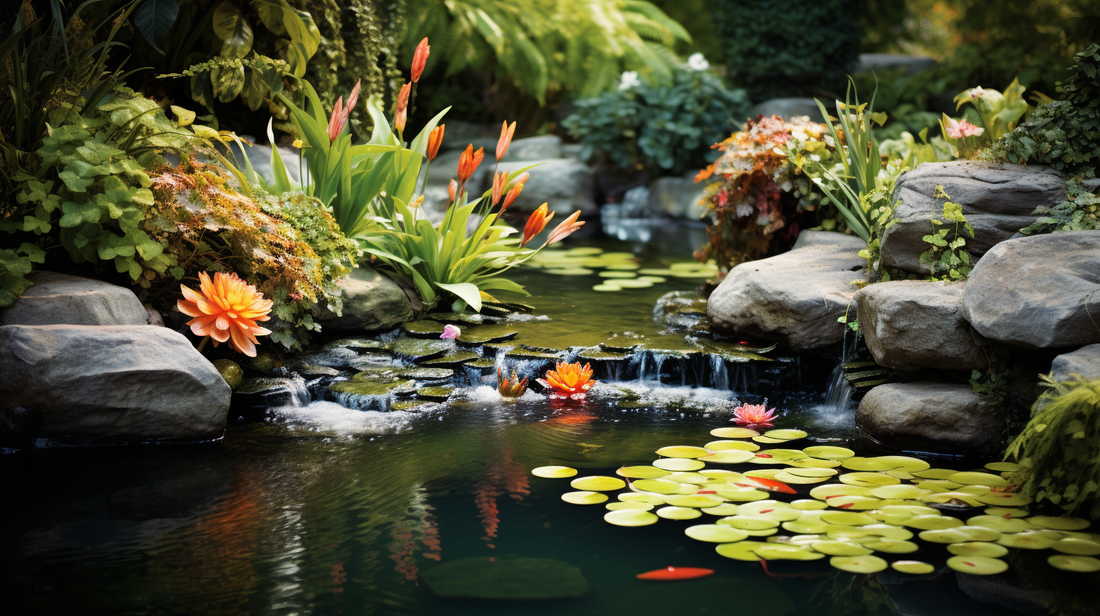Wondering how to lower the pH level in a pond or home water feature? If you’re pond supports a diverse population of fish or plants, water pH, or “potential for hydrogen” is an important metric to keep in mind.
Too high or low of a pH level in a pond can make the fish uncomfortable, impacting their ability to reproduce, process food, and fight bacteria and diseases in the water. PH level can also impact the health of any pond plants you might have in or around the pond.
While it can sometimes be a challenge to manage the pH level in your water, it’s more than possible with the right tools and information. In this article, we take a look at how to lower your pond pH, maintaining water pH levels, and more.
What does pH measure?
PH, “potential for hydrogen” measures the concentration of hydrogen ions in the water. The measurement is expressed on a scale of 0-14, which can help to give an understanding of the acidity or basicity (alkalinity) of the water.
The pH scale is determined by a logarithmic function, which means one unite change on the scale represents a 10X change in hydrogen ion concentration in the water. 7.0 is considered a neutral water reading, but depending on your pond’s requirements, the ideal pH range can vary.
What causes high pH in ponds?
PH levels can change as a result of a number of different factors. Having a rising pH level or a pH level that’s too high is much more common than having a lower pH. More often than not, it’s other minerals and nutrients seeping into the pond that are responsible for raising the pH.
Here are a few more reasons as to why the pH in your pond may be high:
- Algae buildup: The accumulation of algae is a common culprit for rising pH levels, unoxygenated water, dying fish, and other common pond problems.
- Plants: Just as an algae bloom can cause problems in your pond, so can substantial growth from normal pond plants, such as water lettuce, pickerelweed, and more. The carbon dioxide uptake from pond plants can often be enough to unbalance the environment and raise the pH.
How to lower pH in freshwater ponds
The reason for the pH imbalance in your pond may or may not correlate with the causes lined out previously. The key to lowering pond pH levels lies in addressing the original problem. In assessing your pond, be sure to take a look at the runoff, algae buildup, and any other factors that may be causing the pH to rise. With that being said, here are a few of the more popular ways to lower pH levels.
1. pH Reducer (pH stabilizer)
Perhaps the easiest way to reduce pH, using a pH stabilizer should help return your pond to its normal levels without too much hassle. With most stabilizers, it’s advised to only apply enough treatment to shift pH levels by 0.5 at a time. For small ponds, try treating the water every few hours, testing the pH each time to make sure you don’t add more product than necessary.
2. Algae Removal
As mentioned previously, algae blooms are the cause of many pond issues, including those related to high pH. Algae consumes large amounts of carbon dioxide and other compounds in the water through photosynthesis, which can throw off the balance of the pond’s ecosystem entirely.
One of the most effective ways to remove algae is with a UV clarifier, a product that will remove algae but won’t harm the fish and other organisms in the pond. Another common way to reduce algae growth is to simply add some oxygenating pond plants to the water feature. This is a great choice if you’re pond has the space and ability to support new plants.
3. Water Change
While it can be a hassle to drain your pond and refill it with new freshwater, in many cases that is all that’s needed to reset the pH. When replacing the water in your pond, it might also be a good idea to add a water conditioner to remove any impurities and heavy metals in the water. Keep in mind that water changes can be stressful for koi, goldfish, and other fishpond species.
4. Manage Plant Growth
Pond plants add both beauty and biodiversity to any environment, but they can also be problematic in certain situations. Similar to with algae blooms, rapid growth from pond plants can remove enough carbon dioxide from the water to significantly shift pH levels. If reducing your pond’s pH levels is urgent, using an herbicide to restrict plant growth may be a suitable option.
How to Lower pH in Koi Pond
If you are wondering how to lower ph in ponds with fish, you’ll have more than one strategy at your disposal. While the previously mentioned methods can work, one of the best ways to lower pH in ponds with fish is to use a KH stabilizer. KH (carbonate hardness) measures the dissolved bicarbonate and carbonate ions in the water.
The suitable KH range for koi ponds is normally between 75 and 200 ppm (parts per million). Raising KH levels is simple, just add sodium bicarbonate (baking soda) or a commercial stabilizer daily until your KH levels return to normal.
Final Thoughts on Lowering Pond pH
In your pond, high pH levels can be present for a number of different reasons. Rapid plant growth and groundwater runoff account for two of the more common factors attributing to high pH. While it can be difficult to deal with, most problems with pH can be addressed using one or more stabilizers.
Try the above mentioned methods to return balance to your pond’s pH levels. More often times than not, regulating your pond with a chemical stabilizer is both the easiest and most effective solution.
